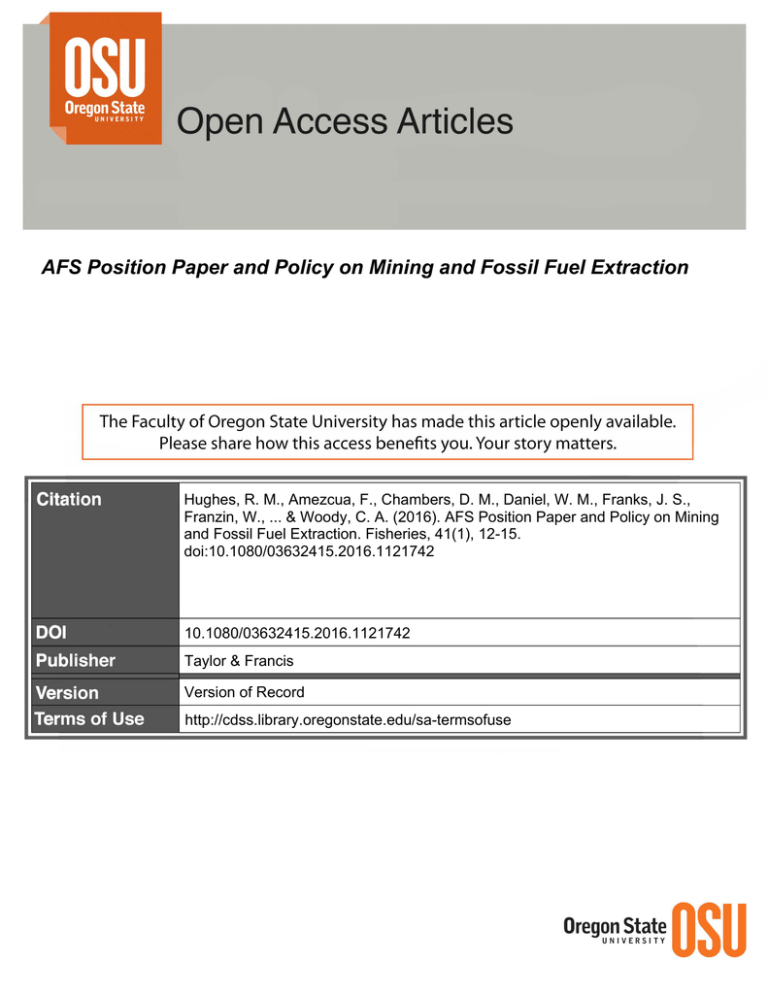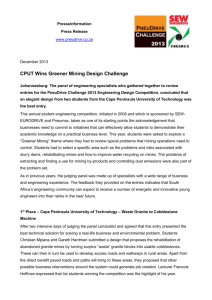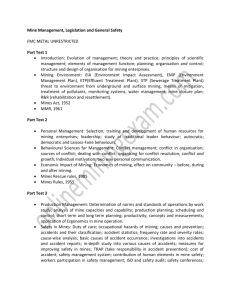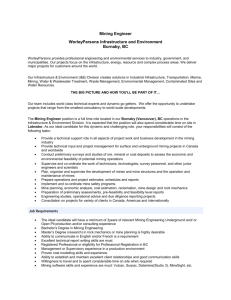AFS Position Paper and Policy on Mining and Fossil Fuel...
advertisement

AFS Position Paper and Policy on Mining and Fossil Fuel Extraction Hughes, R. M., Amezcua, F., Chambers, D. M., Daniel, W. M., Franks, J. S., Franzin, W., ... & Woody, C. A. (2016). AFS Position Paper and Policy on Mining and Fossil Fuel Extraction. Fisheries, 41(1), 12-15. doi:10.1080/03632415.2016.1121742 10.1080/03632415.2016.1121742 Taylor & Francis Version of Record http://cdss.library.oregonstate.edu/sa-termsofuse AFS NEWS AFS Position Paper and Policy on Mining and Fossil Fuel Extraction Robert M. Hughes Amnis Opes Institute and Department of Fisheries & Wildlife, Oregon State University, Corvallis, OR 97333. ­ E-mail: hughes.bob@amnisopes.com Felipe Amezcua Instituto de Ciencias del Mar y Limnologia, Universidad Nacional Autónoma de Mexico, Mazatlán, Sinaloa, México Downloaded by [Oregon State University] at 13:35 22 January 2016 David M. Chambers Center for Science in Public Participation, Bozeman, MT Wesley M. Daniel Department of Fisheries and Wildlife, Michigan State University, East Lansing, MI James S. Franks Gulf Coast Research Laboratory, University of Southern Mississippi, Ocean Springs, MS William Franzin Laughing Water Arts & Science Inc., Winnipeg, Manitoba, Canada Donald MacDonald MacDonald Environmental Sciences Limited, Nanaimo, British Columbia, Canada Eric Merriam Division of Forestry, Natural Resources and Design, West Virginia University, Morgantown, WV George Neall Retired Mining Engineer, Fulks Run, VA Paulo dos Santos Pompeu Departmento de Biologia, Universidade Federal de Lavras, Lavras, Minas Gerais, Brazil Lou Reynolds Freshwater Biology Team, U.S. Environmental Protection Agency Region III, Wheeling, WV Carol Ann Woody Center for Science in Public Participation, Anchorage, AK Following a four-year period of writing, member comment, and multiple revisions, the AFS Position Paper and Policy on Mining and Fossil Fuel Extraction was approved unanimously by the membership at the Society’s annual business meeting August 19, 2015, in Portland, Oregon. The entire document can be read at fisheries.org/policy_statements; a brief summary follows. TECHNICAL BACKGROUND Mining (hard-rock, aggregate, deep, and surface) and fossil fuel (coal, oil, gas) extraction have the potential to significantly alter aquatic ecosystem structure and function. Adverse impacts on water quality, hydrology, physical habitat structure, aquatic biota, and fisheries include elimination and contamination of receiving waters (USEPA 2011; USEPA 2014); significantly altered algal, macroinvertebrate, and fish assemblages (e.g., Pond et al. 2008; Lavoie et al. 2012; Daniel et al. 2014; Figure 1); impairments of aquatic-dependent wildlife (USEPA 2011; USEPA 2014); and climate change (Hansen et al. 2013). For example, even at low concentrations, mining-associated contaminants, such as copper, impair salmonid olfactory function (McIntyre et al. 2008), thereby increasing predation susceptibility (McIntyre et al. 2012); alter salmonid migratory behavior (Sprague et al. 1965; Lorz and McPherson 1976); increase disease susceptibility (Baker et al. 1983); and reduce growth (Marr et al. 1996). 12 Fisheries | Vol. 41 • No. 1 • January 2016 Despite predicted compliance of permit conditions, many operating metal mines have violated water quality criteria (Kuipers et al. 2006). Those permit conditions, or applicable regulations, are minimum requirements and typically do not represent best management practices. Also, the applicable regulations rarely account for the cumulative effects of pollution from multiple mines. Under the General Mining Act of 1872 in the United Sates, federal law transfers metal wealth from the public to mining companies, and shifts clean-up liability from those companies to taxpayers. The half-million abandoned hard-rock mines in the United States could cost US$72-240 billion to rehabilitate (USEPA 2000; NRC 2005), and the over 100 abandoned metal mines in Quebec are estimated to cost over US$600 million to remediate (Hamilton et al. 2015). In both cases, the majority of those costs will fall on taxpayers (Woody et al. 2010; Chambers et al. 2012; Hamilton et al. 2015). In addition, those estimates do not include rehabilitation of the newer, larger mines being Downloaded by [Oregon State University] at 13:35 22 January 2016 Figure 1. Percent generally intolerant fish individuals as a function of mine density for the conterminous USA (n = 33,538). Mines include coal, hard rock, uranium, and aggregate mines. developed in more inhospitable environments, nor the costs of spills, failures, and accidents. Such a spill into the Animas River occurred on August 5, 2015, when U.S. Environmental Protection Agency contractors were assessing leaks of toxic metals in the vicinity of the abandoned Red, Bonita, and Gold King mines near Silverton, Colorado, and broke the debris dam of a holding pond (Vox 2015). That spill sent 12 million liters of contaminated water downstream and into the states of New Mexico and Utah via the San Juan River; the costs of fish kills, water monitoring, clean-up, and loss of water use by recreationalists, irrigators, and other users have been estimated in the tens of millions of dollars. The Mt. Polley tailings pond failure on August 4, 2014, which spilled 14 million m3 of metals-contaminated water and sediments into Hazeltine Creek and Polley and Quesnel Lakes in central British Columbia, has been estimated to cost at least $500 million (US) to rehabilitate (Uechi 2014). Because of various economic factors, the numbers of serious and very serious tailings dam failures such as these have increased since 1960 (Bowker and Chambers 2015). Surface mining temporarily eliminates surface vegetation and permanently changes topography and hydrology, as with mountain-top-removal-valley-fill (MTRVF) coal mines (Fritz et al. 2010; USEPA 2011). Reclaimed surface mines create a leach bed for ions producing toxic conductivity concentrations (Pond et al. 2008), whereas altered hydrology produces flashy flows similar to those in urban areas (Ferrari et al. 2009; USEPA 2011). Underground mines produce acid mine drainage that can eliminate most aquatic life across extensive regions or alkaline mine drainage that alters ionic balance of freshwater ecosystems (USEPA 1995; USEPA 2000). Instream and gravel bar aggregate mining and dredging can alter channel morphology and increase bed and bank erosion, which can reduce riparian vegetation and impair downstream aquatic habitats (Kondolf 1994). Oil and gas wells and product transport can cause devastating spills in freshwater and marine ecosystems (e.g., AP 2012; Amezcua-Linares 2013; Keller 2015). Hydraulic fracturing to extract residual oil and gas can contaminate groundwater and alter surface water ecosystems (Entrekin et al. 2011; Weltman-Fahs and Taylor 2013). Fish biodiversity and macroinvertebrate taxa richness were negatively correlated with the number of well pads per catchment and total mercury concentrations in crayfish, and Brook Trout Salvelinus fontinalis were positively correlated with well pads per catchment (Grant et al. 2015). Smith et al. (2012) concluded that fewer than one well pad per 3 km2 and 3 ha per pad were needed to minimize damage to Brook Trout populations. Bamberger and Oswald (2012) and Webb et al. (2014) documented a wide range of health effects as a result of exposure to fracking fluids and gases. McKenzie et al. (2012) reported cumulative cancer risks of 10 per million for residents living <800 m from a gas well. Stacey et al. (2015) and Cil (2015) associated lowered infant health with proximity of drinking water wells to gas wells. The casings and grouting of abandoned oil and gas wells should be expected to eventually leak and contaminate surface and ground water (Dusseault et al. 2000). In addition, fossil fuel combustion is fundamentally altering the global climate, sea levels, and ocean chemistry (e.g., Orr et al. 2005; Dai 2013; Hansen et al. 2013). Catastrophic mine tailings failures have killed hundreds of thousands of fish and hundreds of people, and contaminated tens to thousands of river kilometers (USEPA 1995; Chambers and Higman 2011; WISE 2011). Oil and gas wells are exempted from regulation by several U.S. laws, despite considerable evidence of their detrimental effects on surface and ground water (Allen et al. 2011; Amezcua-Lineares 2013; Keller 2015). PROPOSED AFS POLICY Mines and wells should only be developed where, after weighing multiple costs, benefits, beneficiaries, and liabilities, they are considered the most appropriate use of land and water by affected publics, can be developed in an environmentally responsible manner, benefit workers and affected communities, and are appropriately regulated. Because of substantial widespread adverse effects of mining and wells on aquatic ecosystems and related human communities, fossil fuel Fisheries | www.fisheries.org 13 combustion effects on global climate, and enormous unfunded reclamation costs for abandoned extraction sites, the American Fisheries Society (AFS) recommends substantive changes in how North American governments conduct environmental assessments and permit, monitor, and regulate mine and fossil fuel development. In particular, AFS recommends that: 1. 2. Downloaded by [Oregon State University] at 13:35 22 January 2016 3. 4. 5. 6. Following a formal environmental impact assessment, the affected public should be involved in deciding whether a mine or well is the most appropriate use of land and water, particularly relative to the need to preserve ecologically and culturally significant areas. Mine or well development should be environmentally responsible with regulation, treatment, monitoring, and sureties sufficient for protecting the environment in perpetuity. Baseline ecological and environmental research and monitoring should be conducted in areas slated for mining and fossil fuel extraction before, during, and after development so that the effects of those industries can be assessed in an ecologically and statistically rigorous manner, and the resulting data should be made publicly available. This policy and related research should help inform the process of responsible resource development for mining and fossil fuel extraction, and should guide the implementation of the precautionary principle for those sectors. A formal risk assessment of the cumulative atmospheric, aquatic, and oceanic effects of continued fossil fuel extraction and combustion should be conducted and reported to the public. A formal risk assessment of the cumulative aquatic and oceanic effects of continued hard rock and aggregate extraction and metals smelting should be conducted and reported to the public. ACKNOWLEDGMENTS This manuscript was improved by review comments from Leanne Roulson. The views expressed in this article are those of the authors and do not necessarily reflect the views or policies of the U.S. Environmental Protection Agency. We thank the National Fish Habitat Partnership and funding from the U.S. Fish and Wildlife Service and the U.S. Geological Survey for supporting development of the data used in Figure 1. REFERENCES Allen, L., M. J. Cohen, D. Abelson, and B. Miller. 2011. Fossil fuels and water quality. Pages 73-96 in P. H. Gleick, L. Allen, J. ChristianSmith, M. J. Cohen, H. Cooley, M. Heberger, J. Morrison, M. Palaniappan, and P. Schulte, editors. The world’s water, volume 7. Island Press, Washington, DC. Amezcua-Linares, F., F. Amezcua, and B. Gil. 2013. Effects of the Ixtoc I oil spill on fish assemblages in the southern Gulf of Mexico. Pages 209-235 in: B. Alford, M. Peterson, and C. Green, editors. Impacts of oil spill disasters on marine fisheries in North America. Taylor & Francis, New York. AP (Associated Press). 2012. Exxon increases estimate of Yellowstone River oil spill by 50%. Website. Available: billingsgazette.com/ news/local/exxon-increases-estimate-of-yellowstone-river-oilspill-by/article_e3f0de2e-f931-50e8-9678-c5f230c9e00d.html. (August 2015). Baker, R. J., M. D. Knittel, and J. L. Fryer. 1983. Susceptibility of Chinook Salmon, Oncorhynchus tshawytscha (Walbaum), and Rainbow Trout, Salmo gairdneri Richardson, to infection with Vibrio 14 Fisheries | Vol. 41 • No. 1 • January 2016 anguillarum following sublethal copper exposure. Journal of Fish Diseases 6:267–275. Bamberger, M., and R. E. Oswald. 2012. Impacts of gas drilling on human and animal health. New Solutions 22:51-77. Bowker, L. N., and D. M. Chambers. 2015. The risk, public liability, and economics of tailings storage facility failures. Available: www. earthworksaction.org/files/pubs-others/BowkerChambersRiskPublicLiability_EconomicsOfTailingsStorageFacility%20 Failures-23Jul15.pdf. (August 2015). Chambers, D. M., and B. Higman. 2011. Long term risks of tailings dam failure. Center for Science in Public Participation, Bozeman, Montana. Chambers, D., R. Moran, L. Trasky, S. Bryce, L. Danielson, L. Fulkerson, J. Goin, R. M. Hughes, J. Konigsberg, R. Spies, G. Thomas, M. Trenholm, and T. Wigington. 2012. Bristol Bay’s wild salmon ecosystems and the Pebble Mine: key considerations for a largescale mine proposal. Wild Salmon Center and Trout Unlimited, Portland, Oregon. Cil, G. 2015. Effects of behavioral and environmental factors on infant health. Doctoral dissertation. Department of Economics, University of Oregon, Eugene, Oregon. Dai, A. 2013. Increasing drought under global warming in observations and models. Nature Climate Change 3:52-58. Daniel, W. M., D. M. Infante, R. M. Hughes, P. C. Esselman, Y.-P. Tsang, D. Wieferich, K. Herreman, A. R. Cooper, L. Wang, and W. W. Taylor. 2014. Characterizing coal and mineral mines as a regional source of stress to stream fish assemblages. Ecological Indicators 50:50-61. Dusseault, M. B., M. N. Gray, and P. A. Nawrocki. 2000. Why oil wells leak: cement behavior and long-term consequences. Proceedings of the International Oil and Gas Conference and Exhibition in China. Society of Petroleum Engineers DOI:10.2118/64733-MS. Entrekin, S., M. Evans-White, B. Johnson, and E. Hagenbuch. 2011. Rapid expansion of natural gas development poses a threat to surface waters. Frontiers in Ecology and the Environment 9:503511. Ferrari, J. R., T. R. Lookingbill, B. McCormick, P. A. Townsend, and K. Eshleman. 2009. Surface mining and reclamation effects on flood response of watersheds in the central Appalachian Plateau region. Water Resources Research 45(4):1–11. Fritz, K. M., S. Fulton, B. R. Johnson, C. D. Barton, J. D. Jack, D. A. Word, and R. A. Burke. 2010. Structural and functional characteristics of natural and constructed channels draining a reclaimed mountaintop removal and valley fill coal mine. Journal of the North American Benthological Society 29:673-689. Grant, C. J., A. B. Weimer, N. K. Marks, E. S. Perow, J. M. Oster, K. M. Brubaker, R .V. Trexler, C. M. Solomon, and R. Lamendella. 2015. Marcellus and mercury: assessing potential impacts of unconventional natural gas extraction on aquatic ecosystems in morthwestern Pennsylvania. Journal of Environmental Science and Health, Part A 50:482-500. Hamilton, P. B., I. Lavoie, S. Alpay, and K. Ponader. 2015. Using diatom assemblages and sulfur in sediments to uncover the effects of historical mining on Lake Arnoux (Quebec, Canada): a retrospective of economic benefits vs. environmental debt. Frontiers in Ecology and Evolution [online serial] 3:99. DOI: 10.3389/ fevo.2015.00099. Hansen, J., P. Kharecha, and M. Sato. 2013. Climate forcing growth rates: doubling down on our Faustian bargain. Environmental Research Letters 8:1-9. Keller, J. 2015. The maddening silver lining to BP’s $18.7 billion penalty. Pacific Standard. Available: www.psmag.com/politics-andlaw/how-come-bp-gets-to-treat-fines-like-business-expensesbut-i-cant-even-get-out-of-this-parking-ticket. (August 2015). Kondolf, G. M. 1994. Geomorphic and environmental effects of instream gravel mining. Landscape and Urban Planning 28:225– 243. Kuipers, J. R., A. S. Maest, K. A. MacHardy, and G. Lawson. 2006. Comparison of predicted and actual water quality at hardrock mines: the reliability of predictions in environmental impact statements. Kuipers and Associates, Butte, Montana. Lavoie, I., M. Lavoie, and C. Fortin. 2012. A mine of information: benthic algal communities as biomonitors of metal contamination from abandoned tailings. Science of the Total Environment 425:231-241. Lorz, H. W., and B. P. McPherson. 1976. Effects of copper or zinc in fresh water on the adaptation to seawater and ATP-ase activity and the effects of copper on migratory disposition of Coho Salmon. Journal of the Fisheries Research Board of Canada 33:2023-2030. Downloaded by [Oregon State University] at 13:35 22 January 2016 Marr, J. C. A., J. Lipton, D. Cacela, J. A. Hansen, H. L. Bergman, J. S. Meyer, and C. Hogstrand. 1996. Relationship between copper exposure duration, tissue copper concentration, and Rainbow Trout growth. Aquatic Toxicology 36:17–30. McIntyre, J. K., D. H. Baldwin, J. P. Meador, and N. L. Scholz. 2008. Chemosensory deprivation in juvenile Coho Salmon exposed to dissolved copper under varying water chemistry conditions. Environmental Science and Technology 42:1352-1358. McIntyre, J. K., D. H. Baldwin, D. A. Beauchamp, and N. L. Scholz. 2012. Low-level copper exposures increase visibility and vulnerability of juvenile Coho Salmon to Cutthroat Trout predators. Ecological Applications 22:1460-1471. McKenzie, L. M., R. Z. Witter, L. S. Newman, and J. L. Adgate. 2012. Human health risk assessment of air emissions from development of unconventional natural gas resources. Science of the Total Environment 424:79-87. NRC (National Research Council). 2005. Superfund and mining megasites: lessons from the Coeur d’Alene River Basin. National Academies Press, Washington, DC. Orr, J. C., V. J. Fabry, O. Aumont, L. Bopp, S. C. Doney, R. A. Feely, A. Gnanadesikan, N. Gruber, A. Ishida, F. Joos, R. M. Key K. Lindsey, E. Maier-Reimer, R. Matear, P. Monfrey, A. Mouchet, R. G. Najjar, G.-K. Plattner, K. B. Rodgers, C. L. Sabine, J. L. Sarmiento, R. Schiltzer, R. D. Slater, I. J. Totterdell, M.-F. Weirig, Y. Yamanaka, and A. Yoo. 2005. Anthropogenic ocean acidification over the twenty-first century and its impact on calcifying organisms. Nature 437:681-686. Pond, G. J., M. E. Passmore, F. A. Borsuk, L. Reynolds, and C. J. Rose. 2008. Downstream effects of mountaintop coal mining: comparing biological conditions using family- and genus-level macroinvertebrate bioassessment tools. Journal of the North American Benthological Society 27:717–737. Smith, D. R., C. D. Snyder, N. P. Hitt, J. A. Young, and S. P. Faulkner. 2012. Shale gas development and Brook Trout: scaling best management practices to anticipate cumulative effects. Environmental Practice 14:1-16. Sprague, J., P. Elson, and R. Saunders. 1965. Sublethal copper–zinc pollution in a salmon river—a field and laboratory study. International Journal of Air and Water Pollution 9:531–543. Stacey, S. L., L. L. Brink, J. C. Larkin, Y. Sadovsky, B. D. Goldstein, B. R. Pitt, and E. O. Talbott. 2015. Perinatal outcomes and unconventional natural gas operations in Southwest Pennsylvania. PLOS One DOI: 10.1371/journal.pone.0126425. USEPA (U.S. Environmental Protection Agency). 1995. Human health and environmental damages from mining and mineral processing wastes. Office of Solid Waste, Washington DC. _____. 2000. Liquid assets: America’s water resources at a turning point. EPA-840, Washington, DC. _____. 2011. The effects of mountaintop mines and valley fills on aquatic ecosystems of the central Appalachian coalfields. Office of Research and Development, EPA/600/R-09/138F, Washington, D.C. _____. 2014. An assessment of potential mining impacts on salmon ecosystems of Bristol Bay, Alaska. EPA 910-R-14-001A-C, Washington, D.C. Uechi, Jenny. 2014. Imperial Metals Mount Polley disaster could cost $500 million, but bonds only a fraction of this amount. Vancouver Observer (August 20). Available: www.vancouverobserver. com/news/imperial-metals-mount-polley-disaster-could-cost500-million-bonds-only-fraction-amount. (August 2015). Vox. 2015. How the EPA managed to spill 3 million gallons of mining waste into a Colorado River. Available: www.vox. com/2015/8/10/9126853/epa-mine-spill-animas. (August 2015). Webb, E., S. Bushkin-Bedient, A. Chang, C. D. Kassotis, V. Balise, and S. C. Nagel. 2014. Developmental and reproductive effects of chemicals associated with unconventional oil and natural gas operations. Reviews on Environmental Health 29:307-318. Weltman-Fahs, M., and J. M. Taylor. 2013. Hydraulic fracturing and Brook Trout habitat in the Marcellus Shale region: potential impacts and research needs. Fisheries 38(1):4-15. WISE (World Information Service on Energy). 2011. Chronology of major tailings dam failures. WISE Uranium Project. Available: www.wise-uranium.org/mdaf.html. (August 2015). Woody, C. A., R. M. Hughes, E. J. Wagner, T. P. Quinn, L. H. Roulsen, L. M. Martin, and K. Griswold. 2010. The U.S. General Mining Law of 1872: change is overdue. Fisheries 35(7):321-331. The World Leader & Innovator in Fish Tags • Call 800-843-1172 to discuss your custom tagging needs • Email us at sales@floytag.com • View our website for our latest catalog www.floytag.com floy tag ad3.indd 1 Fisheries | www.fisheries.org 1/24/2013 6:45:34 PM 15







